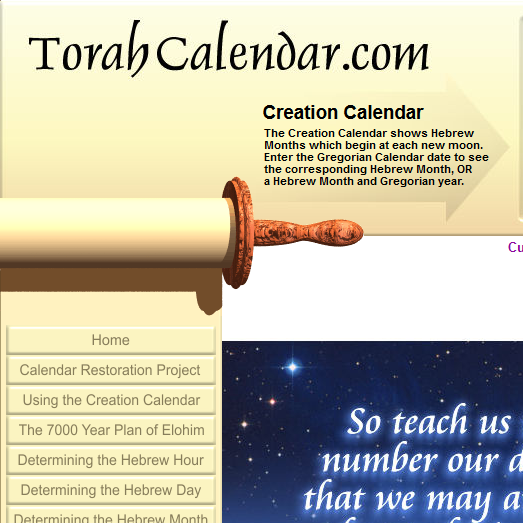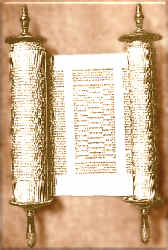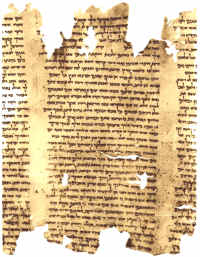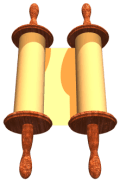The Parashah Cycle
The Torah of
יהוה
An ancient Torah Scroll written in Hebrew
and opened to a column showing
Exodus 15:1-19.
Genesis, Exodus, Leviticus, Numbers and Deuteronomy comprise the first five books of
Scripture. These five books are called the Torah of Moses a total of
20 times in Scripture, and are simply called the Torah.
These books are also known as the Pentateuch. The Torah contains the written statutes,
right rulings and commandments of
יהוה
and has been referred to as the Law, although the precise meaning of
the Torah is hitting the mark.
The word Torah derives from the Hebrew yarah which figuratively
refers to an archer shooting an arrow straightly. Torah carries the idea of
pointing in the right direction or hitting the mark, while sin carries the
idea of missing the mark. The instructions of
יהוה
in the Torah are there to point all people in the right direction that they might
enter into the Age of Life.
As a result of the promises made to Abraham, and the saving work of
יהושע
the Messiah, anyone who embraces and lives by the narrow way of the Torah - who
believes and obeys
יהושע
the Messiah, will enter into the Age of Life in Jubilee Year 120 since
the creation
(Genesis 6:3).
The Parashah
Tradition holds that in the fifth century B.C.E., Ezra the scribe and the 120
elders of the Great Assembly created an annual reading schedule in which the
entire Torah could be read in one year. They divided the Torah into sections
and read one section each Sabbath. Each individual section was called a
Parashah. Collectively, all the readings were called parashot.
Parashah means portion and masoretic codices exist
which exhibit
Parashah divisions. The title of each Parashah typically consists
of a few Hebrew words from within the first verse of the Parashah. Parashot
are not divided according to the modern chapter breaks in Scripture. In the
Creation Calendar, the Torah is divided into 54 parashot. Each Parashah can
be further divided into seven subsections called aliyot.
With the possible exception of the last Parashah, parashot are read sequentially
throughout the year on weekly Sabbaths.
The appointed time of Shemini Atzeret occurs on Day 22 of Month 7
according to
Leviticus 23:36.
The annual reading of the Torah begins with
the first Parashah Bereshit which is read on the first weekly Sabbath
after Shemini
Atzeret. The last Parashah Ve-Zot Ha-Berakhah is always read on Day 21 of
Month 7 whether it is a weekly Sabbath or not. Ve-Zot Ha-Berakhah,
translated as And This is the Blessing, is the only
Parashah which is read on a calendrical date rather than on a weekly Sabbath.
Day 21 of Month 7 is called the Day of Salvation or Hoshana Rabbah.
Hoshana Rabbah is traditionally the day when the Torah scroll is carried around the
inside of the synagogue, making the seven circuits.
This commemorates the events that happened on the seventh day the
Israelites marched around Jericho when Joshua entered the Promised Land. According to
Leviticus 23:34,
Day 21 of Month 7 is the seventh day of the festival of Sukkot
which is in the seventh month.
This day is historically and prophetically significant as it was the day the Messiah
stood in the Second Temple and spoke these words:

John 7:37-39 In the last, the great day of the feast,
יהושע
stood and cried, saying, "If any one is thirsty, let him come to Me and drink. He who
believes in Me, as the Scripture has said, out of his innermost being will flow
rivers of living water." But this He spoke concerning the Spirit, whom those
believing in Him were about to receive; for the Set-Apart Spirit was not yet given,
because
יהושע
was not yet esteemed.
The Messiah was saying that anyone who believed Him would become a renewed
spiritual being who would ultimately inherit the Age of Life.
יהושע
the Messiah spoke these words on the very day that Parashah #54 is to be read. The idea
that Israel would become a renewed spiritual nation in the
Age of Life was the blessing Moses was talking about in
Parashah #54 And This is the Blessing.

Deuteronomy 33:26-29 There is none like the El of Jeshurun,
who rides on the heavens to help you, and in the clouds in His majesty. The
eternal Elohim is your refuge, and beneath are His arms during the ages. He will cast
out your enemy before you, saying, "Destroy him!" Then shall Israel dwell in
safety - Jacob's spring secure in a land of grain and new wine, where the heavens
drop dew. Blessed are you, O Israel! Who is like you? A people saved by
יהוה
- He is your shield and help, and your excellent sword. Your enemies are subdued
for you, and you will trample down their high places.
The 54 parashot are traditionally read once every year in a cycle known as the
Parashah cycle. However, the Parashah is not read on weekly Sabbaths occurring
on or during the appointed times which are described in
Leviticus 23:4-44,
as there are special readings for those days. The Parashah cycle is referred to by James in
Acts 15:19-21
when he gave a ruling concerning the minimum requirements of
fellowship for new believers joining the community of faith in
יהושע
the Messiah.

Acts 15:19-21 Therefore my judgment is not to trouble those who from the
nations are turning to Elohim, but to write to them to abstain from the defilement
of idolatry, and from sexual immorality, and from strangled things, and from blood.
For Moses has been taught throughout many generations in every city, being read in
the synagogues every Sabbath.
James concludes his ruling with the statement that the Torah of Moses had been taught
throughout many generations in synagogues every Sabbath.
He ruled that all new believers must abstain from idolatrous
worship (worship of images, worship of demons, worship involving pagan rituals,
worship of Elohim in a way He did not prescribe), sexual immorality
(pre-marital sex, adultery, rape, incest, homosexuality, bestiality) and
from strangled things and from blood (eating unclean animals, fish, birds
or insects that do not comply with
Leviticus 11:1-47
or eating clean animals
that have not been properly slaughtered with the blood properly removed). An open letter
with this ruling was preserved for posterity in
Acts 15:23-29.

Acts 15:23-29 The apostles, the elders, and the brothers, To the brothers
in Antioch, Syria, and Cilicia: Greetings. Since we have heard that some who went
out from us have troubled you with words, subverting your souls, saying, "You must
be circumcised," to whom we gave no charge, It seemed good to us, having come together with one accord, to send chosen men to you with our beloved Barnabas and Paul -
men who have surrendered their lives for the name of our Master
יהושע
Messiah. We have therefore sent Judas and Silas, who will also declare the same thing
by word of mouth. For it seemed good to the Set-Apart Spirit and to us to lay upon you
no greater burden, except these necessary things: to abstain from idolatrous worship,
and blood, and strangled things, and sexual immorality; If you keep yourselves free
from such things, you will do well. Be strong!
The logic James gives for his decision is that these instructions have been taught
for generations in the weekly Parashah cycle, and they will continue to be
taught. James looked to the Torah in making his ruling. Parashah #26
Shemini deals with the difference between the clean and the unclean
(Leviticus 11:1-47).
Parashah #29 Acharei Mot deals with the
Scriptural definition of food: a clean animal not strangled that has been drained
of its life blood
(Leviticus 17:10-16),
and with sexual immorality
(Leviticus 18:1-30).
Parashah #17 Yitro and Parashah #45
Va-Ethchanan deal with idolatry in the first three of the 10 Commandments
(Exodus 20:1-17,
Deuteronomy 5:1-22).
As years in the Creation Calendar can have 12 or 13 lunar months, and
appointed times can occur on weekly Sabbaths, the total number of available days when
the Parashah is read can vary from year to year.
For any given year, it can range from 47 to 54 reading days.
Traditionally, this problem has been resolved
by providing from 1 to 7 doublings where two sequential Parashah
portions are read together on certain Sabbaths.
The original intent and purpose of the ancient Parashah Cycle has been restored
in the Creation Calendar at TorahCalendar.com. The Creation Calendar offers Parashah
readings for any year selected. The Rabbinic Calendar operates under certain unscriptural
"rules of postponement."
יהוה
gave no rules of postponement for His
appointed times in
Leviticus 23:1-44.
All rules of postponent are contrary to
Elohim.
The assignment of Parashah readings on the Creation Calendar will differ
from those on the Rabbinic Calendar. When viewing months in the
Creation Calendar, click on any Sabbath day to see the corresponding
Parashah readings.
The Haftarah
A fragment of the Book of Isaiah from the Dead Sea Scrolls.
The Haftarah consists of additional readings
taken mostly from the Prophets (Nevi'im) as well as some from the Writings (Ketuvim).
The Haftarah portions are generally read after the
Torah readings as part of the weekly Parashah cycle. These readings generally have a
thematic link with the corresponding Parashah readings.
Historically, the origins of the Haftarah are uncertain. When Judea was under the rule
of the Seleucid king Antiochus IV Epiphanes between 175 B.C.E. to 164 B.C.E., the
reading of the Torah was forbidden.
Some historians believe that the Haftarah cycle originated during that time.
Later, when it was once again possible to read the Torah, the Haftarah cycle was
retained and incorporated into the Parashah cycle.
The 54 Parashah Readings
Genesis 1:1-6:8
"In the Beginning"
Exodus 25:1-27:19
"An Offering"
Numbers 13:1-15:41
"Send"
Exodus 27:20-30:10
"You Shall Command"
Numbers 16:1-18:32
"Korah"
Genesis 12:1-17:27
"Go Out"
Exodus 30:11-34:35
"When You Take"
Numbers 19:1-22:1
"The Ordinance Of"
Genesis 18:1-22:24
"And He Appeared"
Exodus 35:1-38:20
"Gathered Together"
Numbers 22:2-25:9
"Balak"
Genesis 23:1-25:18
"Life of Sarah"
Exodus 38:21-40:38
"The Inventory"
Numbers 25:10-29:40
"Phinehas"
Genesis 25:19-28:9
"Generations"
Leviticus 1:1-6:7
"And He Called"
Numbers 30:1-32:42
"Tribes"
Genesis 28:10-32:2
"And He Went Out"
Leviticus 6:8-8:36
"Command"
Numbers 33:1-36:13
"The Journeys Of"
Genesis 32:3-36:43
"And He Sent"
Leviticus 9:1-11:47
"The Eighth"
Deuteronomy 1:1-3:22
"Words"
Genesis 37:1-40:23
"And He Settled"
Leviticus 12:1-13:59
"Conceived Seed"
Deuteronomy 3:23-7:11
"And I Pleaded"
Genesis 41:1-44:17
"At the End Of"
Leviticus 14:1-15:33
"Leper"
Deuteronomy 7:12-11:25
"Reward From"
Genesis 44:18-47:27
"And He Drew Near"
Leviticus 16:1-18:30
"After the Death"
Deuteronomy 11:26-16:17
"See!"
Genesis 47:28-50:26
"And He Lived"
Leviticus 19:1-20:27
"Set Apart"
Deuteronomy 16:18-21:9
"Judges"
Exodus 1:1-6:1
"The Names"
Leviticus 21:1-24:23
"Speak"
Deuteronomy 21:10-25:19
"When You Go Out"
Exodus 6:2-9:35
"And I Appeared"
Leviticus 25:1-26:2
"On the Mountain"
Deuteronomy 26:1-29:9
"When You Enter"
Leviticus 26:3-27:34
"In My Statutes"
Deuteronomy 29:10-30:20
"You Are Standing"
Exodus 13:17-17:16
"When He Had Sent"
Numbers 1:1-4:20
"In the Wilderness"
Deuteronomy 31:1-30
"And He Went"
Exodus 18:1-20:26
"Jethro"
Deuteronomy 32:1-52
"Give Ear"
Exodus 21:1-24:18
"The Judgments"
Numbers 8:1-12:16
"When You Kindle"
Deuteronomy 33:1-34:12
"And This Is The Blessing"
The 7 Parashah Doublings
There are seven defined Parashah doublings in which two sequential Parashah
portions are read on the same Sabbath. Obviously, there are no doublings needed in years
having 54 available reading days, yet all seven doubling sets must be used in years having
only 47 reading days. Doubling sets occur starting with the lowest
numbered doubling sets and progressing to the higher numbered doubling sets as necessary.
























